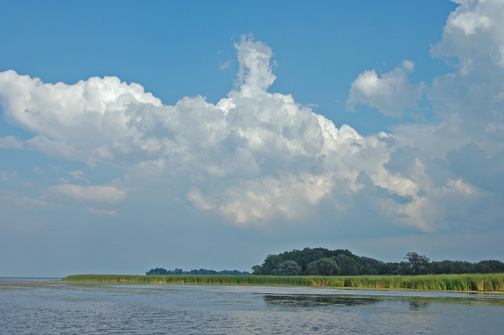The rise and fall of cormorant populations has been linked in the last decade to the reduction of DDT, the rise of round goby as a food, and the pressure from fishermen. Only a few islands in eastern L. Ontario and the north shore of Canada support the breeding colonies with hundreds of pairs, but both DEC and Wildlife Management in Canada have killed or removed nests to reduce population.
Because I see the cormorants on Braddock Bay and and other areas along the shore, I have been fascinated watching them. Sometimes they create long, single-file lines, flying just on top of the waves.
Their twig nests are high in trees inland, but they fish and dry wings on old branches sticking up in the water.
I would not like to see these amazing birds be 'culled' or nests removed. Photo from Univ. of Oregon. For more on the EPA's concern about Double-Crested Cormorants: http://www.epa.gov/med/grosseile_site/indicators/cormorants.html
NOTE: The University of Illinois "Carbon Capture Report" [a website that tracks perceptions in climate change, carbon capture and more] picked up this post: http://hydro.carboncapturereport.org/cgi-bin//profiler?key=westspit.blogspot.com&pt=4
The International Joint Commission (IJC) was established by the Boundary Waters Treaty of 1909 to help manage the use of shared waters between Canada and the United States. In the 1950s, it approved construction and operation of a hydroelectric power project in the St. Lawrence River near Cornwall, Ontario and Massena, New York for the purpose of producing hydroelectricity, enabling seaway navigation, and providing flood protection to Lake Ontario.
The IJC invites stakeholders to participate in this dialogue about a new approach, currently under development, to regulating the flows through the Lake Ontario-St. Lawrence River (LOSLR) system. The new approach would take a step toward more natural water levels and flows in order to improve environmental conditions in the system, particularly on Lake Ontario, and would maintain most of the economic benefits of the current regulation regime. The IJC will consider the comments made during this dialogue before finalizing a formal proposal and scheduling public hearings on the new approach.
Overall Objective for the Dialogue
The Lake Ontario-St. Lawrence River (LOSLR) system is home to nearly 12 million people, and a variety of interests, including shoreline communities, recreational boating, commercial navigation, hydroelectric power, municipal and industrial water uses, and the environment. While fluctuations in water levels and flows are mainly determined by mother nature, regulating the flows through an international hydropower project also has an influence. Dialogue participants are invited to discuss how a new approach to regulation would affect water levels and flows, and each of the various interests on the lake and river.
To discuss issues regarding the draft new approach with experts and stakeholders throughout the LOSLR system. The desired outcomes include: Resolution of outstanding questions to the greatest extent possible; Deeper understanding of the issues by all participants, including the IJC, governments and stakeholders throughout the LOSLR system.
Extend the moratorium on issuing fracking permits until June 1, 2013, A7400-A/S.6261 -- Contact this link to send message to Governor and Legislature: Riverkeepers Action Alert on Fracking.

